Radiometric dating Study guides, Class notes & Summaries
Looking for the best study guides, study notes and summaries about Radiometric dating? On this page you'll find 158 study documents about Radiometric dating.
All 158 results
Sort by
 Popular
Popular
-
Animal Diversity 8th Edition By Hickman - Test Bank
- Exam (elaborations) • 363 pages • 2023
-
- $22.77
- 1x sold
- + learn more
Animal Diversity, 8e (Hickman) Chapter 1 Science of Zoology and Evolution of Animal Diversity 1) A characteristic of science is that A) it is not explained by natural laws. B) its hypotheses are testable. C) its conclusions are final. D) it is not falsifiable. E) it seeks to define the vitalistic forces of life. Answer: B Section: 01.01 Topic: Principles of Science Learning Objective: 01.01 Explain that science consists in testing, possibly rejecting, and improving our simplest and be...
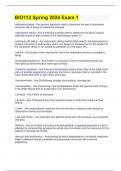
-
BIO112 Spring 2024 Exam 1 Terms
- Exam (elaborations) • 8 pages • 2024
-
- $11.49
- + learn more
radiometric dating ,radiocarbon dating,potassium-40 dating, half-life, punctuated equilibrium, Cambrian explosion, macroevolution, microevolution, Linnaeus, Lamarck,Cuvier,Lyell and Hutton,Malthus,descent with modification,selective breeding The process of humans intentionally selecting a few organisms with desired traits to serve as parents of the next generation, over time producing organisms with altered characteristics species a group of related organisms sharing a distinctive form. If se...
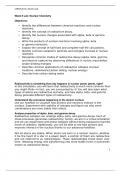
-
CHEM 120 Week 6 Virtual Lab; Nuclear Chemistry.
- Other • 11 pages • 2023
- Available in package deal
-
- $20.99
- + learn more
Week 6 Lab: Nuclear Chemistry Objectives: • Identify the differences between chemical reactions and nuclear reactions. • Identify the concept of radioactive decay. • Identify the nuclear changes associated with alpha, beta or gamma decay. • Write the products of nuclear reactions involving alpha, beta or gamma emissions. • Explain the concept of half-lives and complete half-life calculations. • Identify common subatomic particles and energies involved in nuclear reactions • ...
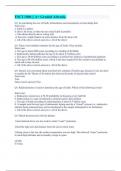
-
ESCI 1006 || A+ Graded Already.
- Exam (elaborations) • 23 pages • 2024
-
- $11.99
- + learn more
Q1: In calculating the size of Earth, Eratosthenes used assumption or knowledge that: Select one: a. Earth is a sphere b. Sun is far away, so that sun rays reach Earth in parallel c. Sun shone directly above a deep well d. Sun cast a slight shadow at some distance from the deep well e. All of the above correct answers e. All of the above Q1: There were multiple estimates for the age of Earth. They include: Select one: a. The age is about 6000 years according to a reading of the Bibl...
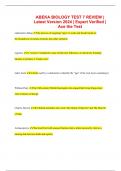
-
ABEKA BIOLOGY TEST 7 REVIEW | Latest Version 2024 | Expert Verified | Ace the Test
- Exam (elaborations) • 8 pages • 2024
- Available in package deal
-
- $8.49
- + learn more
radiometric dating the process of assigning "ages" to rocks and fossils based on the breakdown of certain elements into other elements eugenics a "science" founded by some of Darwin's followers, of selectively breeding humans to produce a "master race" index fossil a fossil used by evolutionists to identify the "age" of the rock layer containing it William Paley the 18th-century British theologian who argued that living things show clear evidence of design
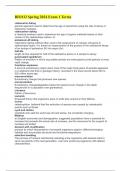
-
BIO112 Spring 2024 Exam 1 Terms
- Exam (elaborations) • 7 pages • 2024
-
- $10.99
- + learn more
BIO112 Spring 2024 Exam 1 Terms radiometric dating general approach used to determine the age of specimens using the rate of decay of radioactive isotopes radiocarbon dating a chemical analysis used to determine the age of organic materials based on their content of the radioisotope carbon-14 potassium-40 dating radiometric dating method often used in the assessment of volcanic intrusions in sedimentary layers. It is based on measurement of the product of the radioactive decay of an isot...
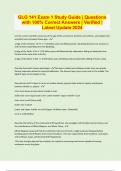
-
GLG 141 Exam 1 Study Guide | Questions with 100% Correct Answers | Verified | Latest Update 2024
- Exam (elaborations) • 11 pages • 2023
-
- $13.49
- + learn more
List the current scientific consensus of the age of the a) Universe, b) Earth, and c) Moon, and explain how scientists have calculated these ages - a) Age of the Universe: 13.77 +/- 0.04 billion years old (Measured by calculating how fast our universe is and has been expanding since the Big Bang) b) Age of the Earth: 4.54 +/- 0.05 billion years old (Measured by radiometric dating of meteorites that formed at the same time as Earth.) c) Age of the Moon: 4.425 +/- 0.025 billion years old (M...
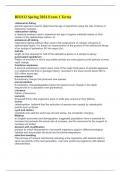
-
BIO112 Spring 2024 Exam 1 Terms
- Exam (elaborations) • 7 pages • 2024
-
- $11.39
- + learn more
BIO112 Spring 2024 Exam 1 Terms radiometric dating general approach used to determine the age of specimens using the rate of decay of radioactive isotopes radiocarbon dating a chemical analysis used to determine the age of organic materials based on their content of the radioisotope carbon-14 potassium-40 dating radiometric dating method often used in the assessment of volcanic intrusions in sedimentary layers. It is based on measurement of the product of the radioactive decay of an isot...
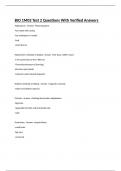
-
BIO 1M03 Test 2 Questions With Verified Answers
- Exam (elaborations) • 10 pages • 2024
-
- $11.49
- + learn more
Angiosperm - Answer -flowering plant -has seeds with casing -has endosperm in seeds -fruit -most diverse Radiometric methods of dating - Answer -K/Ar (lava, 500K+ years) -C14 (conversion to N14, 40K yrs) -Thermoluminescence (burning) -Electron spin (teeth) -Uranium Lead (mineral deposits) Relative methods of dating - Answer -magnetic reversals -extinct and distinct species Primate - Answer -climbing/locomotion adaptations -big brain -opposable thumbs and prehensile tails -na...
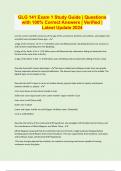
-
GLG 141 Exam 1 Study Guide | Questions with 100% Correct Answers | Verified | Latest Update 2024
- Exam (elaborations) • 11 pages • 2024
-
- $10.49
- + learn more
List the current scientific consensus of the age of the a) Universe, b) Earth, and c) Moon, and explain how scientists have calculated these ages - a) Age of the Universe: 13.77 +/- 0.04 billion years old (Measured by calculating how fast our universe is and has been expanding since the Big Bang) b) Age of the Earth: 4.54 +/- 0.05 billion years old (Measured by radiometric dating of meteorites that formed at the same time as Earth.) c) Age of the Moon: 4.425 +/- 0.025 billion years old (M...

How did he do that? By selling his study resources on Stuvia. Try it yourself! Discover all about earning on Stuvia


